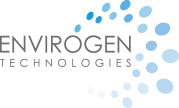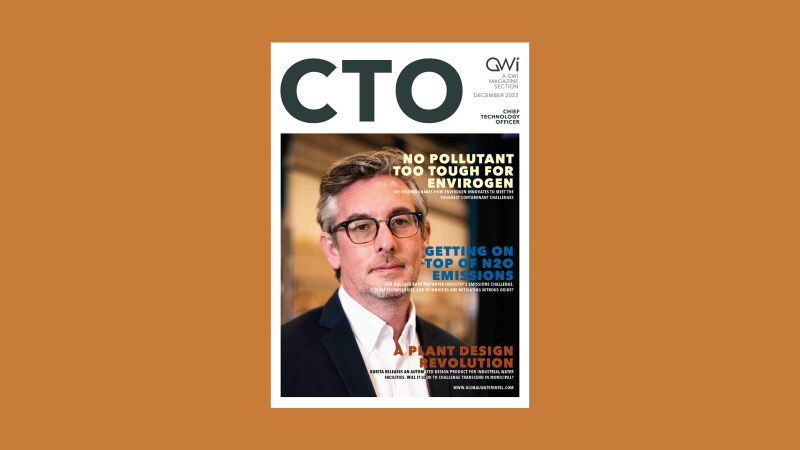Global Water Intelligence (GWI) have released their latest, December 2022, GWI Magazine. The cover of this month’s CTO Outlook section features an interview with Envirogen CEO Joe Higgins on opportunities within green hydrogen and local circular economies. A full copy of the interview is shown below. Alternatively, you can download a full version.

Tackling tricky contaminants is a speciality of Envirogen, which applies innovative solutions across myriad industries and applications. CEO Joe Higgins shares his outlook on the water opportunities within green hydrogen and local circular economies.
What are the main drivers of your water technology strategy?
Developing sustainable solutions that are customer-centric is the key driver of our technology strategy. We are “technology agnostic”. When developing an offer our objective is to provide the optimum solution with the lowest overall costs, including installed capital and operating, over the project’s life. Whole-life costs are often forgotten when considering a solution, but these can be a substantial part of the overall project costs.
What are the key technology areas you are looking at in your R&D and why?
For our flagship fluidised bed reactor (FBR) technology, we are continuously enhancing the performance of our water remediation systems to reach sub ppb levels of nitrate, perchlorate, selenium, hexavalent chromium and 1,4 dioxane. Over the past two decades, Envirogen’s FBR has successfully treated water and wastewater streams containing contamination from rocket fuel, solvents and toxic metals.
In addition, we are currently piloting various technologies with our customers for emerging contaminants such as trinitrotoluene (TNT), 2,4-dinitroanisole (DNAN), hydrazine, 1,2,3-TCP, arsenic, and nickel. In parallel, we are enhancing our rare earth metal recovery process to provide a more economical solution for markets such as acid mine drainage.
On the potable and industrial water production side, we are enhancing our technologies for nitrate and hexavalent chromium and further developing our solutions in aquaculture and recycling/reuse.
Where do you look outside of Envirogen Group for innovation?
We regularly partner with universities, government agencies and other technology companies. For example, we are working with the US government (Department of Defense) to further the development of our FBR technology to treat recalcitrant contaminants. I’m particularly interested in combining our technologies with complementary ones to enhance the efficiency and capability of our technology to optimise our solutions for our customers.
What gaps do you see in the Envirogen Group water technology portfolio that could be strengthened?
Our strength is in delivering bespoke and innovative solutions to our customers, particularly in treating emerging contaminants, reuse, odour control and industrial water. As a company, we are cognisant that we must sometimes integrate complementary technologies to provide an optimum solution for our customers. In that regard, we have developed strong partnerships to allow us to offer turn-key solutions. Notwithstanding this, a fundamental tenet of our offering is that we take full responsibility for our solutions through long-term operations and service contracts.
For example, we built and operate the Nevada Environmental Response Trust (NERT) facility in Henderson, Nevada, the world’s largest oxyanion treatment facility. This treatment system utilises Envirogen’s FBR technology to significantly reduce these oxyanion contaminants from groundwater, eventually discharging this treated water to the Las Vegas Wash, Lake Mead, and the Colorado River. In performing this treatment, we protect significant downstream potable water receptors.
Which of the industrial markets that Envirogen Group is active in have the greatest need for water & wastewater treatment innovations and why?
We are very active in the food & beverage market, where we see the integration of water reuse and recycling needing more acceptance by our customers.
In the mining, military, chemical and power markets, we see a requirement to reach sub-ppb levels for both traditional and emerging contaminants. Our approach is to provide proof of concept by piloting, which allows us to offer performance guarantees. In terms of piloting, the focus is predominantly on treatability. Often, the optimisation step is not a customer focus, where we see huge potential for reducing whole-life costs.
The use of biological treatment for drinking water, and in our case using the FBR, is an area that requires further industry acceptance. This is particularly relevant in the current economic climate where biological treatment can significantly reduce OPEX or where waste disposal is limited or not a preferred option. Nanofiltration is also becoming more commonplace, particularly in drinking water treatment.
What developments do you see in the water reuse technology market?
For us, the key enabler of reuse is applying hollow fibre nanofiltration in conjunction with appropriate pre-treatment. We have successfully implemented several hollow fibre nanofiltration projects, all of which have beneficial return on investment for our customers and contribute to reducing their water footprint.
What changes are you seeing in the water disinfection market?
From our perspective, a key driver for the disinfection process is to limit the use of chemicals. For example, we often use UV in conjunction with hydrogen peroxide. The UV operating at a wavelength of 254 nm can damage the DNA of bacteria and most waterborne microorganisms, preventing their reproduction. Meanwhile, hydrogen peroxide offers the significant advantage of only degrading into water and oxygen; it oxidises organic matter and does
not generate by-products as chlorine or bromine do. Using UV and hydrogen peroxide together provides a very efficient and safe disinfection method without any by-products. For applications that call for chemical addition, we prefer chlorine dioxide due to its sterilising capacity and ability to generate it on-site, which negates the requirement to transport chemicals.
How do you see the water technology market responding to growing concerns regarding emerging contaminants?
Our approach to new contaminants has been their degradation and removal using a combination of physical, chemical, and biological treatment techniques. As every situation is different and experimental data is insufficient to provide precise predictions for the mechanistic degradation and removal fate of emerging contaminants, we tend to pilot for proof of concept.
I believe the market will move more towards using advanced oxidation processes (AOP), biological treatment technologies and nanofiltration. Combining technologies is particularly appropriate for recalcitrant emerging contaminants, where one technology (e.g. AOP) produces partial degradation while a second technology (e.g. FBR) completes the degradation and a third technology (e.g. nanofiltration) removes any residuals. Where applicable, we prefer biological treatment, applying our FBR, as it generally provides the most sustainable and cost-effective treatment solution.
What are your activities in hydrogen production and what changes do you see for the future of this water-related market?
I believe with the deployment of CO2 policy and hydrogen incentives, demand for hydrogen will rise, and its use will gain traction. As evaporatively-cooled coal power plants become obsolete, the large amount of water they consume will be reallocated. Freeing up that water supply will permit new electrolytic hydrogen production in renewable energy-rich areas, which are currently considered water-constrained. In my opinion, using hydrogen as a renewable energy source will lead to water savings, not expenditures, in the long term. Improvements are needed in the energy efficiency of electrolysers, which is currently the limiting factor.
In our experience, the cost and complexity of producing demineralised water highly depend on source water quality. This is essential, as water infrastructure can be up to 10% of hydrogen projects’ installed cost. Many regions may turn to large-scale wastewater reuse to support water demand.
Much of the water consumed in electrolysis can be recovered if hydrogen is used in processes that permit steam recovery. We are working with customers to reuse the by-product water from the industrial use of hydrogen. Hydrogen production yields large quantities of oxygen. For each megawatt of electrolyser power, approximately 3.9 tons per day of oxygen is released. This poses an enormous opportunity for developing innovative oxygen-dependent applications, including wastewater treatment and aquaculture.
What do you think will be the game-changing technologies in the water sector in the next ten years? What is ripe for disruption?
There is scope for further innovation in membrane filtration systems, AOP, biological remediation, hybrid natural and advanced treatment systems, microbial fuel cells, and electrochemical and nanotechnology. However, business-as-usual approaches and traditional technological choices for water management will not be able to address the many future challenges sufficiently. The way we think about water is ripe for disruption. I believe there will be a move towards semi-centralised approaches to locally extract maximum benefit (e.g. nutrients, energy and water) from each specific water resource using a range of technologies, giving the potential for a green local economy.
Disruptive innovation may come in the form of making benefits from today’s larger-scale innovative technologies viable at a smaller scale. This would permit local application and allow water to be harvested for resources and reused multiple times locally through cascading water-use approaches depending on water quality requirements.
Also, the nexus between water production and energy utilisation needs to continue towards increasing efficiency. This has improved over the years with RO systems having more efficient pre-treatment and utilising two- and three-stage pass systems. Still, more R&D is required to reduce the energy footprint of the transport and treatment of water. I see the updates in electrodialysis technology as one of these potential game-changers.

